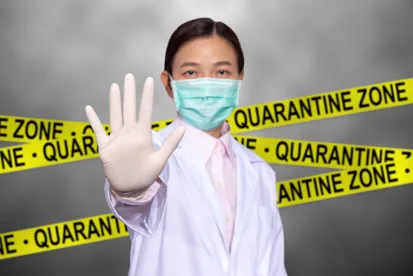In light of recent civil unrest within the United States, which has been accompanied by incidents of property damage and large crowd actions, hospitals and healthcare facilities should consider reviewing and ensuring that their emergency preparedness plans, policies and procedures take into account potential complexities posed by facility evacuation plans during the novel coronavirus (COVID-19) pandemic. Civil unrest in a community could reach the point that a hospital or other healthcare facility, such as an ambulatory facility or nursing facility (collectively, Facilities), determines it is appropriate to implement lockdown procedures, shelter in place or otherwise enact aspects of the Facility’s emergency preparedness and evacuation plans. Complex in even the best of circumstances, facilities must be especially mindful of implementing these actions in a pandemic environment, both with confirmed COVID-19 patients and those who may be exposed to them as a result of evacuation efforts.
IN DEPTH
Hospital Evacuation and Shelter-in-Place Concepts
As current episodes of civil unrest in a number of states escalate to include areas where hospitals and other healthcare facilities (Facilities) are located, those Facilities should be prepared to implement aspects of their emergency preparedness plans in response if needed. Depending upon the circumstances attendant to the unrest—for example, whether there is a risk of damage to the Facility’s building, equipment or life safety systems; chance of staff or patient harm; or lack of supplies—a Facility may determine that imposition of a temporary shelter-in-place and lockdown order or a more drastic plan to evacuate staff and patients is required to ensure safety during times of crisis. Coordination with emergency management agencies and state health authorities is of key importance to these planning efforts. Some hospital associations and state agencies have developed toolkits for implementing both shelter-in-place and evacuation scenarios.
If a Facility identifies a risk that civil unrest in its community could lead to staff or patient harm, a decision for the Facility to shelter in place and lock down is the first course of action to consider to safeguard staff and patients. A shelter-in-place order is a protective strategy to maintain patient care within the Facility, while limiting the movement of patients, staff and visitors to protect both people and property. Coupled with a lockdown to restrict access in and out of the Facility, shelter-in-place techniques can be effective in preserving safety without the risks that come with attempting to relocate patients to other locations or facilities. Many Facilities have already limited visitation and movement throughout their locations due to the COVID-19 pandemic, such that minor additional safeguards (such as posting reminders to report unidentified visitors, and instructions regarding how to contact security or local law enforcement if unauthorized individuals enter or attempt to enter the Facility) may be more easily incorporated. Additionally, staff education around the need to remain vigilant in entering and leaving the Facility, and reminders on hospital codes that may be called overhead during times of crisis—such as color-themed codes used to report violent behavior, trespassers, or unknown objects that could be explosive or otherwise harmful—helps socialize the aspects of a safe shelter-in-place environment.
Should the circumstances be such that shelter-in-place is not sufficient to ensure safety of staff and patients, a partial or complete evacuation may become necessary. Evacuation means the removal of staff and some or all patients to another Facility or care location due to an emergency situation. The Department of Health and Human Services’ Agency for Healthcare Research and Quality (AHRQ) has published a decision tree for decision-making after an event that occurs with no warning, as would likely be the case with heightened instances of civil unrest. Clearly, evacuation poses risks to patients and requires significant time and resources to achieve. Deciding which patients are evacuated and when (e.g., sickest patients first or ambulatory patients first), also presents medical ethics questions. Facilities are well advised to incorporate elements of an evacuation plan, with logistics and alternatives mapped out, as part of their emergency preparedness plans to permit quick action as circumstances require.
Condition of Participation: Emergency Preparedness Plans
Under the Social Security Act and existing Medicare regulations, Facilities are required to develop and maintain a comprehensive emergency preparedness program that complies with all federal, state and local emergency preparedness requirements. In connection with their emergency preparedness program, Facilities must develop and implement emergency preparedness policies and procedures. These policies and procedures generally must be reviewed and updated at least every two years. At a minimum, Facility policies and procedures must address basic needs for staff and patients in times of emergency, regardless of whether the Facility elects to evacuate patients or to shelter in place. Many Facilities are already functioning under their emergency preparedness plans as a result of the COVID-19 pandemic; however, anticipating the compounded potential needs brought about by civil unrest raises further issues for consideration.
Emergency preparedness plans should address maintaining an appropriate store of food, water, medical and pharmaceutical supplies and alternative sources of energy to maintain appropriate temperatures, emergency lighting, fire detection, extinguishing and alarm systems and sewage and waste disposal in times of crisis. Given the supply chain issues experienced as a result of the COVID-19 pandemic, Facilities may not be well stocked in some of these areas at the present time, and an effort to assess readiness in these areas is advisable in case the Facility finds itself unable to maintain or procure supplies during times of unrest. Facilities are required to track the location of any on-duty staff and sheltered patients in the Facility’s care during an emergency, including any patients that must be relocated during the emergency. If patients are relocated, the Facility must document the name and location of the receiving facility or other alternative care site where patients are relocated. (See CMS State Operations Manual, Appendix Z: Emergency Preparedness for All Provider and Certified Supplier Types (Appendix Z), Tag E-0018, which details the requirement for each provider type to develop policies and procedures that provide for documentation and tracking.)
Although the Medicare Conditions of Participation (CoPs) related to emergency preparedness do not explicitly require facilities to account for infection control, Facilities should consider the impact of the COVID-19 pandemic on the Facility’s emergency preparedness policies and procedures to ensure and maintain the appropriate care and isolation of infectious COVID-19 patients, as noted below.
Importantly, emergency preparedness plans require providers to include a process for cooperation and collaboration with local, regional, state and federal emergency preparedness officials to assist in maintaining an integrated response during a disaster or emergency situation (see Appendix Z). Facilities may need to request regulatory flexibility or notify the applicable state authority if the facility determines that it is necessary to institute or modify the Facility’s emergency preparedness plan in light of civil disobedience. Facilities may want to consider their current policies and procedures for securing the Facility and perimeter and evaluate whether current processes to maintain security are appropriate and adequate if a lockdown is required. If a Facility engages its own or contracted security, the Facility may want to evaluate whether the number and frequency of patrols reflects the present risk level in the Facility’s community.
Special Considerations for the COVID-19 Pandemic: Patients and Resources
A Facility considering movement or evacuation of patients must also consider those patients with COVID-19 infections, to ensure that the Facility’s plan addresses whether, how and when to move infectious COVID-19 patients in the event of an evacuation, including the prioritization of patients in the event of an evacuation. In general, non-ambulatory COVID-19 patients who are subject to interventions like isolation, mechanical ventilation or continuous nursing care may not be good candidates for evacuation. However, the Facility’s procedures should address how the Facility will maintain continuity of care for patients receiving treatment for COVID-19 in light of any necessary decisions to evacuate patients or shelter in place. The Facility may also want to locate and evaluate whether there are any alternative care sites that may be available to accommodate COVID-19 patients who need to be evacuated.
The ability of a Facility to maintain isolation and the Facility’s available resources to maintain isolation precautions for the safety of personnel and patients should also be assessed. The COVID-19 pandemic has created shortages in personal protective equipment (PPE); the Facility should take stock of its available PPE to ensure that the Facility has an appropriate quantity of PPE to properly protect any patients who must be evacuated and maintain isolation for any confirmed or suspected COVID-19 patients during the period of crisis.
Key Takeaways
In light of recent civil unrest and acknowledging the stress already placed on Facilities as they provide medical services during the COVID-19 pandemic, Facilities should consider a review and update of their emergency preparedness plans to ensure that any potential evacuation or shelter-in-place and lockdown guidelines properly account for infectious COVID-19 patients. Careful, advance coordination with local public health agencies and law enforcement is strongly recommended, to ensure an understanding of the Facility’s plan and how it may need to be implemented should there be instances of significant civil unrest that risks harm to patients or staff and compromises the ability to provide care.






 />i
/>i

